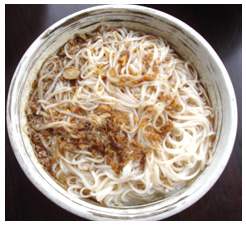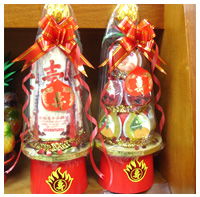Origin of noodle
Noodle customarily refers to a properly cooked strip-shaped food made of flour produced by grinding wheat. According to the oldest historical records, the noodle originated from around the Han Dynasty (206 BC -AD 24), when the plantation and production of wheat had reached a certain scale and a fairly high level in term of production technologies and cooking utensils, but the wheaten food of that time was called "Bing" (cake), instead of "Miantiao" (noodle) as called nowadays. The literature of that time had recorded about some strip-shaped wheaten foods, e.g. "Hanju" (a fried wheaten food in the shape of a ring), "Zhazi" (fence), which, was different from the noodle we know, are more like the dim sums we eat today. Liu Xi of Dong Han Dynasty mentioned in his book Shiming- Explaining Foods and Drinks that "Suobing" (chain cake) was named for its shape, and this Suobing was considered as the embryonic form of noodles. However, since this food might appear much earlier than the Dong Han Dynasty, we may roughly conclude that noodle appeared no later than the Han Dynasty.
After the Tang Dynasty, noodle developed into its maturity and was more popular. Such custom as eating longevity noodle, an auspicious token of long life, on birthday was entrenched in the Tang dynasty. Chu I of the Song Dynasty depicted in I-Chueh-Liao Tsa-Chi that "In the Tang Dynasty, people usually prepared soup noodles on birthday", and the poem written by Lu YuXi to felicitate the birthday of Zhang Shou contains a verse: "Raise chopsticks to savour the soup cake". Moreover, as recorded in the Chapter on Empress and Imperial Concubines of the Tang History, the empress of Xuan-Zhong Emperor mentioned that her farther once exchanged his new purple waistcoat for a bucketful of flour to prepare the birthday soup cake for the emperor, and this soup cake should be the predecessor of today’s birthday longevity noodle.
Origin of string noodle
 In the history of Chinese wheaten foods, few documents mention "string noodle", but among all types of noodles, there are some finest wheaten foods such as the "Dragon Whisker Noodle". The string noodle, which is also a type of noodle, is mostly popular in Fuzhou, which is why the Taiwan string noodle is often called Fuzhou string noodle, seemingly to indicate the origin of Taiwan string noodle. In the history of Chinese wheaten foods, few documents mention "string noodle", but among all types of noodles, there are some finest wheaten foods such as the "Dragon Whisker Noodle". The string noodle, which is also a type of noodle, is mostly popular in Fuzhou, which is why the Taiwan string noodle is often called Fuzhou string noodle, seemingly to indicate the origin of Taiwan string noodle.
The book "Anecdotes about the Famous Chinese Foods" refers to the "Fuzhou string noodle", saying that "Fuzhou string noodle is a famous traditional savoury food produced under rigid requirements, with enriched white flour as raw material, through six steps, namely, making dough, slivering, rubbing dough strands, stringing the dough rings, and repeatedly pulling and then coiling the dough strings ", This production procedure is similar to that of the handmade string noodle we observed, and therefore we may infer that the "Fuzhou string noodle" referred to in this book is exactly the string noodle we discussed herein and that the craft of making Taiwan string noodles was introduced from Fuzhou.
The "Anecdotes about the Famous Chinese Foods" also mentioned that Fuzhou string noodle can be traced back to the end of Tang Dynasty, or more than one thousand years ago. In Bei Song Dynasty, the poet Huang Shan-Gu travelled to Fujian and admired the delicious string noodles he tasted there, he wrote down these verses: "Silvery threads tangling in the bowl are the soup cakes, a wisp of threads drawn suggesting a jade twig thwart". Legend says that Hsi Wang Mu’s (Queen Mother of the West) daughter, Jiu Tian Xuan Nu, endeavored to make the string noodles as a present to congratulate her mother on her birthday, whence the saying that even today, the makerss of string noodles all worship the statues of Jiu Tian Xuan Nu.
Significance of string noodle
 Since the string noodle is fine and long. Legend says that Jiu Tian Xuan Nu made it as a present to congratulate her mother on her birthday, it symbolizes longevity. In Fuzhou, people is accustomed to eating longevity noodles, namely string noodles cooked in chicken soup and served with an egg added, which signifies safety and longevity, on birthday, and to present the peace noodles to the folks and friends who are about to make a long journey and the guests arriving or leaving, in the hope that they will be blessed safe and healthy. The same is true of the customs of the Taiwanese, who cook longevity noodles to celebrate birthday and pray for longevity and safety with the string noodles, which are also used on such occasions as wedding, sacrificing to the deities, removal of misfortune, etc., to signify blessings of safety and health. These shall also be the customs developed from the Fujianese customs. As regards the saying that the pettitoes string noodles can remove misfortune, some people reason that since the pettitoes suggest stepping on pig dung, the worst mishap, the pettitoes string noodles imply that out of the depth of misfortune comes the bliss. Hence, the string noodle is considered as a good offering to deities for longevity and removal of misfortune in Taiwan. Since the string noodle is fine and long. Legend says that Jiu Tian Xuan Nu made it as a present to congratulate her mother on her birthday, it symbolizes longevity. In Fuzhou, people is accustomed to eating longevity noodles, namely string noodles cooked in chicken soup and served with an egg added, which signifies safety and longevity, on birthday, and to present the peace noodles to the folks and friends who are about to make a long journey and the guests arriving or leaving, in the hope that they will be blessed safe and healthy. The same is true of the customs of the Taiwanese, who cook longevity noodles to celebrate birthday and pray for longevity and safety with the string noodles, which are also used on such occasions as wedding, sacrificing to the deities, removal of misfortune, etc., to signify blessings of safety and health. These shall also be the customs developed from the Fujianese customs. As regards the saying that the pettitoes string noodles can remove misfortune, some people reason that since the pettitoes suggest stepping on pig dung, the worst mishap, the pettitoes string noodles imply that out of the depth of misfortune comes the bliss. Hence, the string noodle is considered as a good offering to deities for longevity and removal of misfortune in Taiwan.
Reference information
- Anecdotes about the Famous Chinese Foods by Tian Yu-Tang, 1994.9, China Commercial Publisher
- Monograph Series on History of Chinese Dietetic Culture by Wang Zihui
- dining and wining in Fujian http://www.a.com.cn/Forum/article_25_1_153342_3.html
- Origin of Wheaten Foods by Zhou Qing-Yuan of China Cereals Industrial Technology Research Institute
|










 In the history of Chinese wheaten foods, few documents mention "string noodle", but among all types of noodles, there are some finest wheaten foods such as the "Dragon Whisker Noodle". The string noodle, which is also a type of noodle, is mostly popular in Fuzhou, which is why the Taiwan string noodle is often called Fuzhou string noodle, seemingly to indicate the origin of Taiwan string noodle.
In the history of Chinese wheaten foods, few documents mention "string noodle", but among all types of noodles, there are some finest wheaten foods such as the "Dragon Whisker Noodle". The string noodle, which is also a type of noodle, is mostly popular in Fuzhou, which is why the Taiwan string noodle is often called Fuzhou string noodle, seemingly to indicate the origin of Taiwan string noodle.
 Since the string noodle is fine and long. Legend says that Jiu Tian Xuan Nu made it as a present to congratulate her mother on her birthday, it symbolizes longevity. In Fuzhou, people is accustomed to eating longevity noodles, namely string noodles cooked in chicken soup and served with an egg added, which signifies safety and longevity, on birthday, and to present the peace noodles to the folks and friends who are about to make a long journey and the guests arriving or leaving, in the hope that they will be blessed safe and healthy. The same is true of the customs of the Taiwanese, who cook longevity noodles to celebrate birthday and pray for longevity and safety with the string noodles, which are also used on such occasions as wedding, sacrificing to the deities, removal of misfortune, etc., to signify blessings of safety and health. These shall also be the customs developed from the Fujianese customs. As regards the saying that the pettitoes string noodles can remove misfortune, some people reason that since the pettitoes suggest stepping on pig dung, the worst mishap, the pettitoes string noodles imply that out of the depth of misfortune comes the bliss. Hence, the string noodle is considered as a good offering to deities for longevity and removal of misfortune in Taiwan.
Since the string noodle is fine and long. Legend says that Jiu Tian Xuan Nu made it as a present to congratulate her mother on her birthday, it symbolizes longevity. In Fuzhou, people is accustomed to eating longevity noodles, namely string noodles cooked in chicken soup and served with an egg added, which signifies safety and longevity, on birthday, and to present the peace noodles to the folks and friends who are about to make a long journey and the guests arriving or leaving, in the hope that they will be blessed safe and healthy. The same is true of the customs of the Taiwanese, who cook longevity noodles to celebrate birthday and pray for longevity and safety with the string noodles, which are also used on such occasions as wedding, sacrificing to the deities, removal of misfortune, etc., to signify blessings of safety and health. These shall also be the customs developed from the Fujianese customs. As regards the saying that the pettitoes string noodles can remove misfortune, some people reason that since the pettitoes suggest stepping on pig dung, the worst mishap, the pettitoes string noodles imply that out of the depth of misfortune comes the bliss. Hence, the string noodle is considered as a good offering to deities for longevity and removal of misfortune in Taiwan.